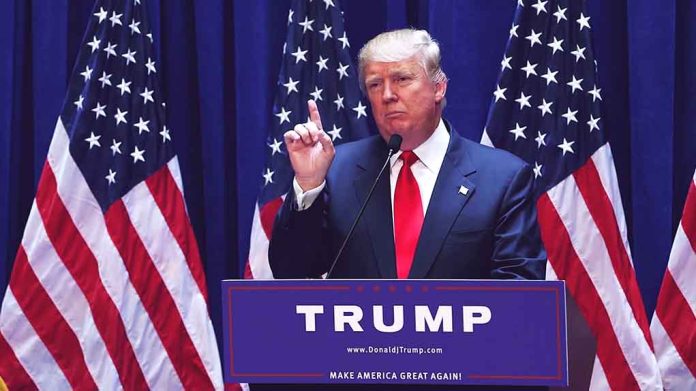
President Trump’s record-shattering 140+ executive orders in his first 100 days have decisively restored America’s sovereignty while completely redefining the bounds of presidential authority in ways that leave Washington’s establishment scrambling to adapt.
Key Takeaways
- President Trump signed over 140 executive orders in his first 100 days, far exceeding his predecessors and demonstrating his commitment to swift action
- Immigration enforcement has been dramatically strengthened, resulting in significant reductions in southern border crossings and increased deportations
- Major tariffs on China and other nations have been implemented to protect American industry and correct trade imbalances
- Government efficiency has improved through substantial federal workforce reductions and spending cuts, with approximately 280,000 job cuts
- Trump’s executive approach has faced legal challenges but demonstrates his determination to fulfill campaign promises with or without congressional support
A Bold New Era of Presidential Action
President Trump’s second term has begun with unprecedented executive authority, marked by over 140 executive orders in just 100 days. This remarkable pace eclipses that of previous administrations and signals Trump’s unwavering commitment to delivering on his campaign promises without delay. The administration’s aggressive approach has targeted key policy areas including immigration, international trade, and government efficiency – all central components of the platform that resonated with American voters in the 2024 election. While critics question the constitutional implications, supporters celebrate the decisive leadership that’s quickly dismantling bureaucratic roadblocks and entrenched inefficiencies that have long hampered American prosperity.
The flurry of executive actions demonstrates President Trump’s understanding that Americans elected him to produce results, not excuses. By leveraging executive authority to its fullest extent, he has circumvented the traditional legislative gridlock that frequently stalls meaningful reform. This approach allows for rapid implementation of policies that address pressing national concerns like border security and economic competitiveness. The administration’s legal team has carefully crafted these orders to withstand inevitable judicial challenges, though several have indeed faced court scrutiny. This tension between executive action and judicial review represents the constitutional checks and balances functioning as designed.
— Speaker Mike Johnson (@SpeakerJohnson) April 29, 2025
Immigration Enforcement and Border Security
President Trump’s immigration initiatives have yielded tangible results with southern border crossings plummeting under enhanced enforcement measures. The administration has prioritized the deportation of illegal immigrants with criminal records while simultaneously strengthening border security infrastructure. These decisive actions fulfill key campaign promises to restore order at the southern border and protect American communities from illegal entry. Despite legal challenges, including a Supreme Court ruling that temporarily halted certain deportations under the Alien Enemies Act, the administration continues to pursue robust immigration policies aimed at ending the crisis created by the previous administration’s open borders approach.
“None of those had the kind of arbitrary, forceful quality of Trump’s actions,” said John Woolley, referring to previous presidents’ executive orders compared to Trump’s more decisive approach.
The effectiveness of Trump’s border policies is evident in the dramatic reduction of illegal crossings and increased deportations of those who have violated our immigration laws. By reinstating successful first-term policies like Remain in Mexico and leveraging executive authority to enhance enforcement, the president has quickly reversed the catastrophic border situation he inherited. These actions have won praise from border communities and law enforcement professionals who witnessed firsthand the chaos created by the previous administration’s negligence. While legal battles continue over specific aspects of the immigration agenda, the administration remains committed to prioritizing American security interests and the rule of law.
— @amuse (@amuse) April 29, 2025
Economic Sovereignty Through Tariffs and Trade Reform
President Trump’s implementation of substantial tariffs, including a 145% rate on Chinese imports, represents a bold reassertion of American economic sovereignty after decades of disadvantageous trade agreements. This strategic approach aims to address the massive trade imbalances that have hollowed out American manufacturing and shipped jobs overseas. The administration has made clear that fair trade, not free trade, is the priority, with Treasury Secretary Scott Bessent emphasizing that China must take responsibility for correcting the imbalance. The tariff strategy extends beyond China to include other nations that have exploited American markets while protecting their own industries.
“I believe that it’s up to China to de-escalate because they sell five times more to us than we sell to them,” explained Treasury Secretary Scott Bessent, highlighting the leverage America holds in trade negotiations.
While some economists express concern about potential market disruptions, the administration maintains that short-term adjustments are necessary to achieve long-term economic security and prosperity for American workers. This approach challenges decades of globalist trade policies that prioritized cheap imports over domestic manufacturing capabilities. President Trump’s tariff strategy is already forcing trading partners to reconsider unfair practices and compelling American companies to reevaluate supply chains with national security implications. The administration’s willingness to use America’s purchasing power as leverage marks a significant departure from previous administrations’ reluctance to defend American economic interests with the same vigor they defended foreign ones.
Government Efficiency and Spending Reforms
The Trump administration has made dramatic progress in trimming federal bloat, with approximately 280,000 government positions eliminated through firings, buyouts, and proposed cuts. This efficiency initiative, supported by Elon Musk’s involvement, represents the most significant government restructuring in decades and directly addresses the taxpayer-funded bureaucratic expansion that occurred under previous administrations. By targeting redundant positions and unnecessary departments, these reforms aim to create a leaner, more responsive government that serves citizens rather than itself. The resulting reduction in federal spending helps address the national debt crisis while redirecting resources to critical areas like border security and national defense.
Major cuts to foreign aid programs reflect President Trump’s America First philosophy, prioritizing domestic needs over international commitments that often yield questionable returns. The administration has systematically reviewed funding for international organizations and foreign assistance programs, redirecting those resources to address pressing domestic concerns. These budgetary reforms represent a fundamental reordering of priorities that places American taxpayers’ interests at the forefront of fiscal decision-making. While establishment voices protest these changes, the administration maintains that fiscal responsibility and domestic investment are essential components of national renewal and long-term strength.
Domestic and International Leadership
On the international stage, President Trump has demonstrated a willingness to challenge the status quo and propose innovative solutions to longstanding conflicts. His peace proposals for Ukraine recognize geopolitical realities while seeking to end the destructive conflict that has drained Western resources. Similarly, his approach to the Middle East focuses on stability and practical solutions rather than endless military engagements with no clear objectives. This pragmatic foreign policy stands in stark contrast to the ideological interventionism that characterized previous administrations, which often embroiled America in conflicts with little connection to vital national interests.
“There is nothing to talk about — it is our land, the land of the Ukrainian people,” stated Ukrainian President Volodymyr Zelenskyy, illustrating the challenges of negotiating peace in the region despite Trump’s efforts to find resolution.
President Trump’s first 100 days have redefined presidential leadership through decisive action, strategic use of executive authority, and a steadfast commitment to the promises that earned him the people’s trust. While legal challenges and institutional resistance continue, the administration has demonstrated remarkable effectiveness in implementing its agenda despite these obstacles. The unprecedented pace and scope of executive orders reflect not just a governing style but a necessary response to the urgent challenges facing the nation. As the administration moves beyond its first 100 days, this pattern of bold leadership and decisive action promises to continue reshaping the presidency and restoring American strength both at home and abroad.







